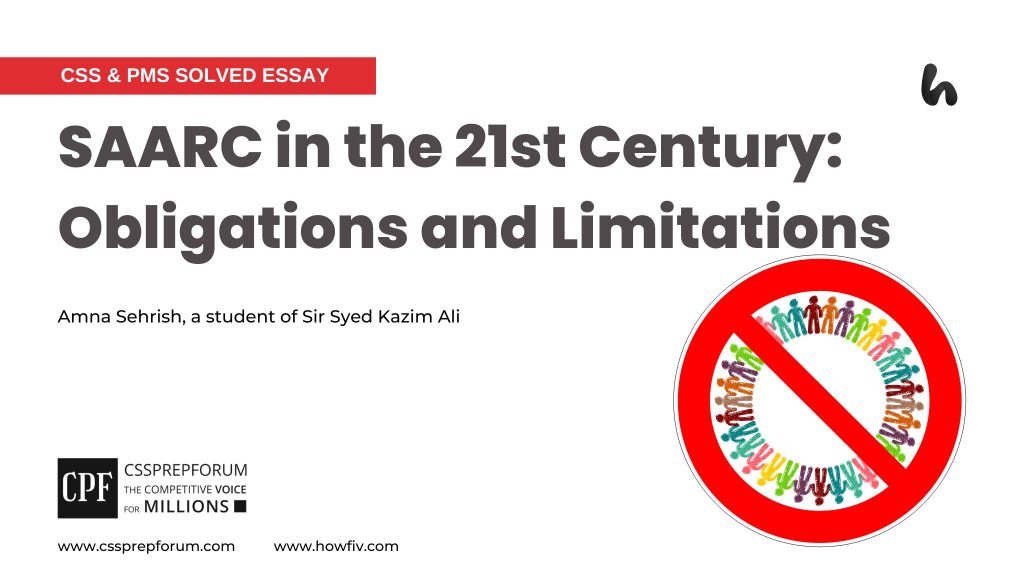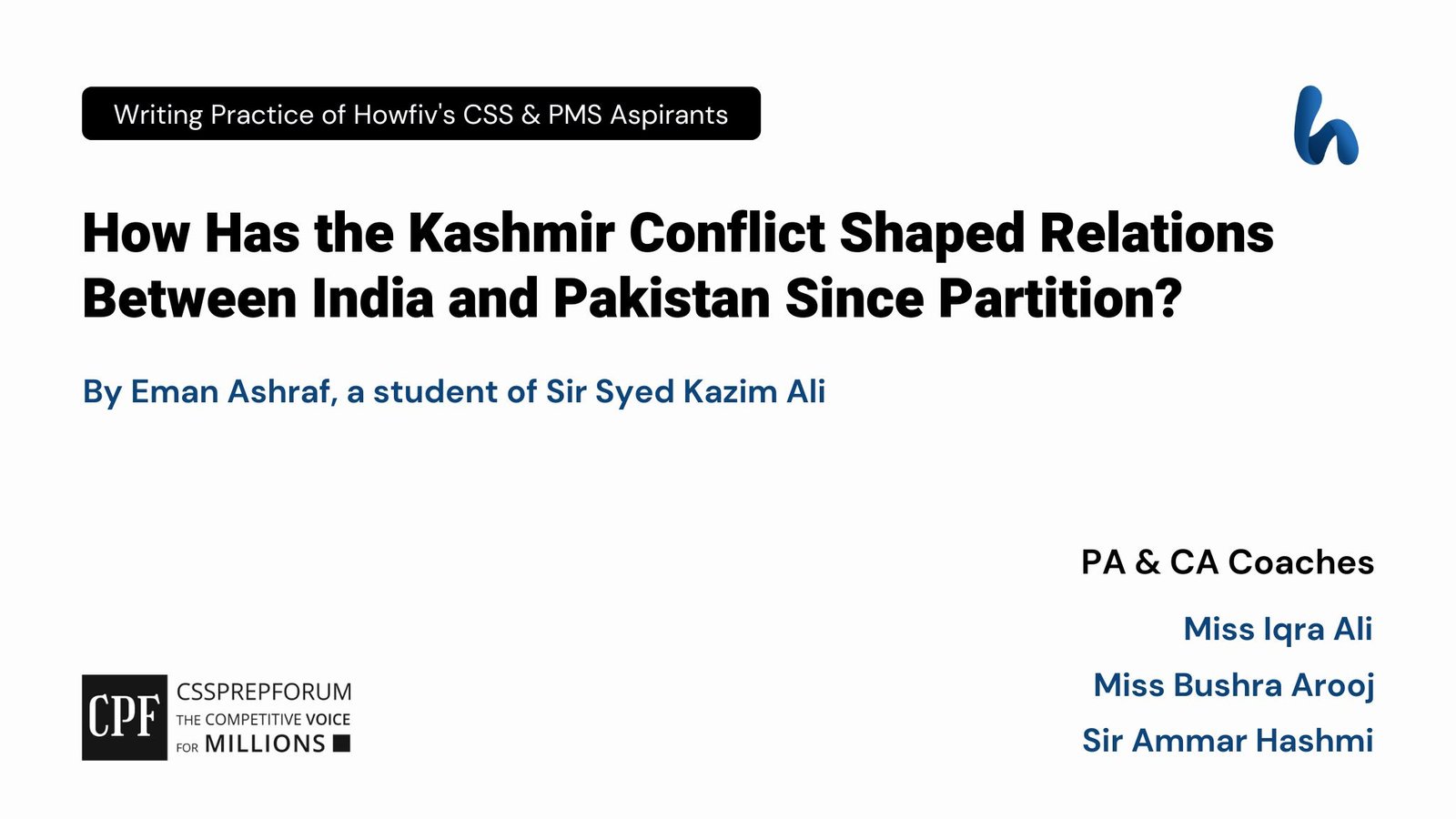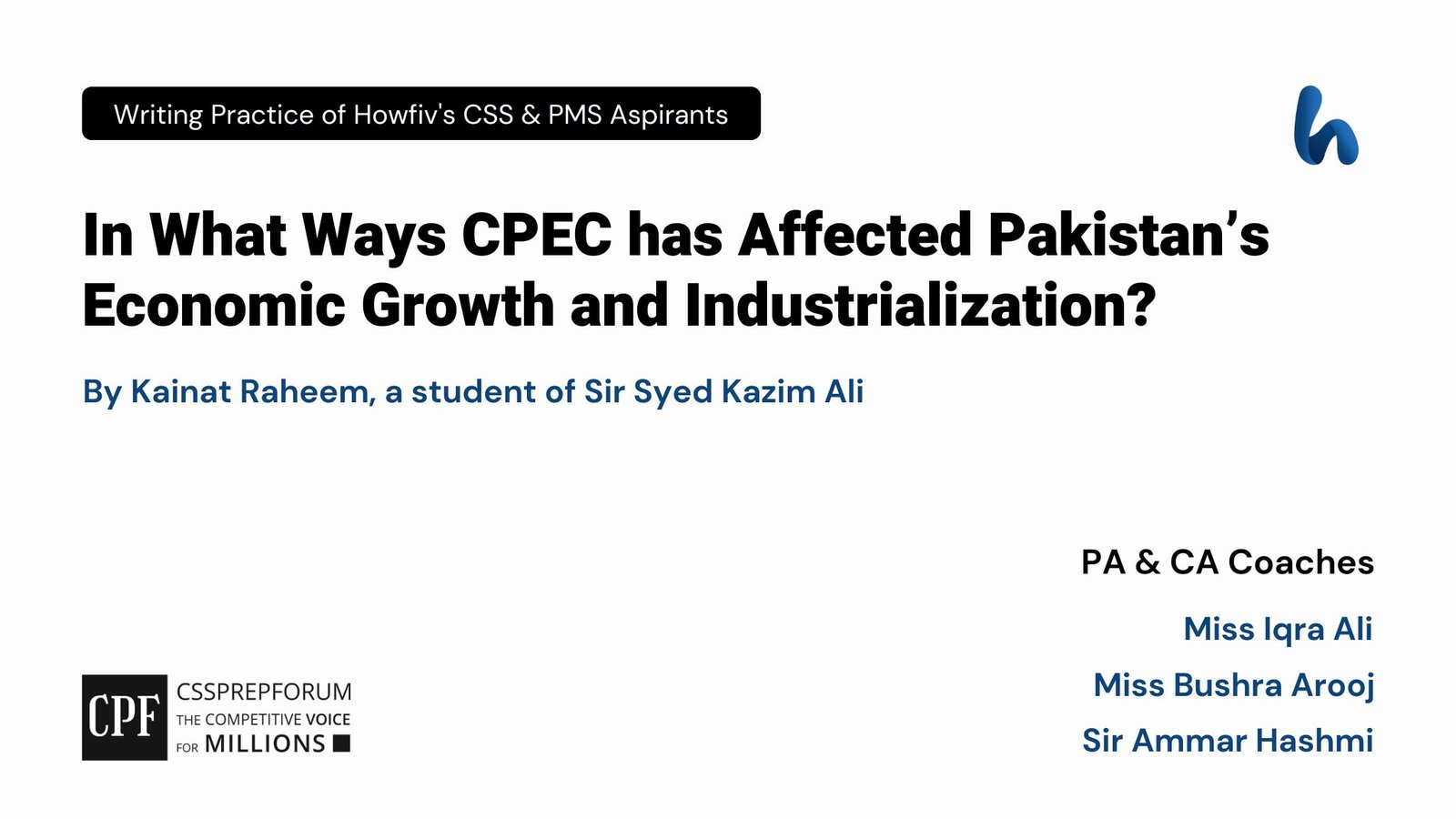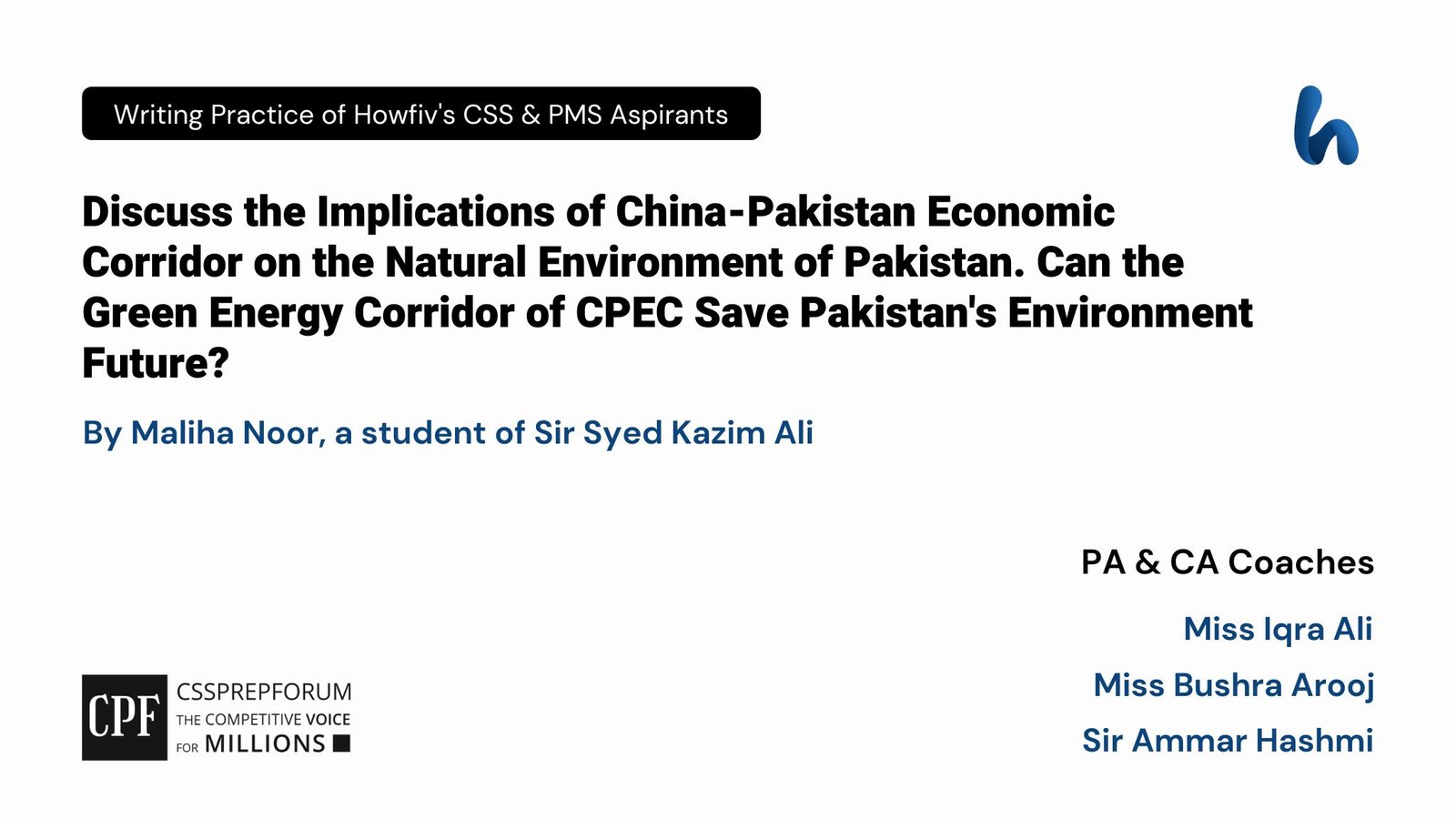SAARC in the 21st Century: Obligations and Limitations | CSS & PMS Solved Essays
Amna Sehrish, a Sir Syed Kazim Ali student, has attempted the CSS & PMS Solved essay “SAARC in the 21st Century: Obligations and Limitations” on the given pattern, which Sir Syed Kazim Ali teaches his students. Sir Syed Kazim Ali has been Pakistan’s top English writing and CSS, PMS essay, and precis coach with the highest success rate of his students. The essay is uploaded to help other competitive aspirants learn and practice essay writing techniques and patterns to qualify for the essay paper.

Outline
1-Introduction
While the South Asian Association for Regional Cooperation (SAARC) plays a fundamental role in promoting regional integration, economic growth, and peace, it faces significant challenges, such as political distinctions, historical conflicts, and limited economic integration. Despite these obstacles, managing these limitations is crucial for realizing SAARC’s potential and fostering regional collaboration, trade, security, and development in the 21st Century.
2-The Genesis and Evolution of SAARC
3-Operational Framework of SAARC
- ✓A SAARC Secretariat’s role and functions
- ✓Regional centre establishment and its objectives
- ✓Significance of Annual Summits
4-SAARC’s Obligations in Regional Cooperation and Integration
- ✓ SAARC’s contributions to stability, peace, and mutual harmony among member states
- ✓Fosters Economic Development and trade liberalization through agreements like SAFTA in SAARC
- ✓Facilitates diplomatic dialogues and political engagement
- ✓Promotes environmental sustainability and mitigation of climate change
- ✓Improves regional cooperation for public health issues and initiatives
5-SAARC’s Challenges and Limitations
- ✓Lack of mutual trust
- ✓Intra-regional security conflict
- ✓Economic barriers and issues in intra-regional trade
- ✓Political instability
- ✓Cultural diversity
6-Prospects of SAARC
- ✓Enhancing people-to-people interaction, tourism, and cultural exchanges
- ✓Prospects in public health, infrastructure development, and knowledge sharing
- ✓Digital connectivity and advanced technology in promoting cooperation
7-What are the potential steps for strengthening SAARC?
- ✓Embracing technology for better collaboration and efficiency
- ✓Creating joint innovation funds and cross-border incubation centers
- ✓Strengthening regional ties through entrepreneurial and cultural exchanges
8-Conclusion

The world is at a critical juncture in the 21st Century, where achieving harmony, peace, and prosperity requires close cooperation on regional and global levels. One region with immense potential for economic growth and development is South Asia, home to a dense population. However, the region struggles with a lack of economic, political, and regional cooperation, which has led to numerous challenges. This is why the role of regional cooperative associations and organizations has become increasingly important, and the South Asian Association for Regional Cooperation (SAARC) is a fundamental interstate organization that aims to promote regional cooperation and integration among its member countries. The organization focuses on fostering economic cooperation, enhancing connectivity and infrastructure, facilitating social and cultural exchanges, and pursuing peace and security to promote regional stability. However, the organization faces several challenges in achieving its goals. For example, political distinctions, bilateral disagreements, and historical conflicts pose considerable hurdles that impede effective collaboration among member countries. Besides, limited improvement in economic integration, institutional limitations, inadequate development levels, and geopolitical landscape difficulties further exacerbate these issues. Despite these challenges, SAARC holds immense prospects for regional amalgamation and cooperation. It is crucial to manage these limitations to achieve the prospects for strengthening regional collaboration, expanding trade and investment, addressing security concerns, increasing people-to-people contacts, and exploring sub-regional cooperation models. Therefore, this essay presents a critical overview of SAARC in the 21st Century and explores its obligations, limitations, and potential way forward. By working together and overcoming political and historical differences, the member countries of SAARC can contribute to the region’s development and pave the way for a brighter future.
Moving forward, SAARC traces its history back to the early 1980s when the leaders of South Asian countries recognized the need for regional cooperation to address common limitations and harness collective opportunities. This drive culminated in the 1985 Dhaka Declaration, which established SAARC with seven founding members: Nepal, Pakistan, Bangladesh, Bhutan, India, Maldives, and Sri Lanka. Later, Afghanistan joined in 2006, broadening the organization’s reach. SAARC was established to promote regional collaboration, economic progress, and cultural understanding, aiming to create peace, stability, and prosperity through collaborative regional efforts among member countries. Moreover, SAARC drew inspiration from the success of ASEAN and the EEC to duplicate their accomplishments in advancing regional integration and cooperation.
Discussing its operational framework, the SAARC Secretariat in Kathmandu, Nepal, is the organization’s operational and functional epicentre. It directs and monitors the implementation of activities and is the primary communication channel between the organization and its member states and other regional organizations. In 2004, SAARC developed regional centres in member countries to focus on various activities and objectives, including agriculture, tuberculosis, documentation, meteorological research, and human resource development as SCC in Kandy, SCZMC in Malé, and SIC in Kathmandu. The organization also established three more regional centres centred on culture, coastal zone management, and information. The organization is also tasked with holding annual summits, the highest authority in SAARC. The summit hosting countries also hold the Chair of the organization. As an illustration, Maldives hosted the seventeenth SAARC Summit in 2011 at Addu City, and Nepal hosted the eighteenth SAARC Summit in 2014 at Kathmandu and presided over it. Likewise, the Nineteenth SAARC summit, which was to be held in Islamabad, Pakistan, has been pending since 2016.
Stepping towards obligations, SAARC has achieved several milestones throughout its history mainly because of regional cooperation and agreements reached during summits. SAARC has significantly contributed to promoting regional peace, stability, and harmony. It has played an essential role in creating mutual consensus, cultural exchanges, and people-to-people interactions, all of which help to preserve regional heritage and diversity. The organization is a catalyst for regional integration and a forum for conversation and consensus-building. This part of SAARC enables member nations to express their concerns, Nepal, Pakistan and work together to solve everyday challenges.
Moreover, SAARC creates an enabling environment for economic development, social advancement, and sustainable growth in the region. The agreement on the South Asian Free Trade Area (SAFTA) was signed during the Twelfth Summit in Islamabad in January 2004. SAFTA entered into force at the end of 2006. The establishment of SAFTA portrays SAARC’s commitment to economic cooperation and integration among member nations. The association has conducted Regional Studies on trade, manufactures and services, environment and poverty alleviation, SAFTA, and Customs matters. Essential agreements and initiatives, such as the SAARC Preferential Trading Arrangement SAPTA and SAFTA and the establishment of specialized centres for various sectors, have contributed to advancing economic cooperation and integration within the region. The organization fosters economic cooperation, trade liberalization, and regional investment promotion.
Next, SAARC promotes regional cooperation and integration among South Asian countries through dialogue and diplomacy. It provides a platform for all member countries to dialogue and address shared concerns and challenges. SAARC facilitates political engagement and high-level diplomatic dialogues through summits and ministerial meetings. SAARC also promotes regional cooperation through diplomacy by providing a shared platform for member countries to discuss and resolve issues through dialogue while avoiding conflicts.
Given South Asia’s particular environmental issues, such as climate change, deforestation, and water shortages, SAARC is crucial to promoting environmental sustainability. SAARC’s obligations include fostering regional cooperation for environmental preservation, climate change mitigation, and the sustainable use of natural resources by prompting and promoting regional dialogue and collaboration. SAARC holds conferences and seminars, creates regional plans, and executes programs that foster environmental conservation and climate resilience. This responsibility is critical to safeguarding the long-term viability of the region’s natural resources and people’s well-being.
SAARC has a crucial role and obligation in improving health cooperation among member nations, particularly in the face of public health issues such as pandemics, infectious illnesses, and healthcare access. The organization develops collaborative ways to strengthen health systems, disseminate information and best practices, and provide effective response mechanisms to health crises. SAARC helps to enhance the region’s public health infrastructure and capacities through programs such as the SAARC Tuberculosis and HIV/AIDS Centre and partnerships on vaccine research and distribution. This position is becoming more crucial in meeting the health demands of South Asia’s densely populated nations while guaranteeing regional health security.
However, SAARC has experienced several problems that have inhibited its success. The limitations holding the organization from reaching its full potential include a lack of mutual trust among member nations, notably between India and Pakistan, which has posed a substantial hurdle to attaining the organization’s objectives. Intra-regional security issues, such as the Kashmir dispute, have resulted in military standoffs and border clashes, hampering regional integration efforts. Furthermore, the low level of intra-regional commerce, hampered by obstacles such as tariffs and non-tariff blockades, has stifled the region’s economic growth and development.
Additionally, one country’s confidence and belief in another country’s intentions and actions are paramount for beneficial mutual relationships. Indeed, trust is essential for the member countries to cooperate and work towards common goals. However, in the context of SAARC, mutual trust has been lacking among the member nations, especially between India and Pakistan, which has impeded the organization’s capability to achieve its goal.
The differences and clashes among the member countries have threatened peace and stability in the region. For example, India and Pakistan have had various disputes over the years, including the Kashmir issue, which has led to army standoffs and border skirmishes. These conflicts have made it difficult for SAARC to promote regional integration and development.
The restricted amount of trade among the member countries also limits the SAARC’s progress. Despite the capability for increased trade, the member countries have not entirely benefited from the opportunities due to various blockades such as tariffs, non-tariff barriers, and lack of infrastructure. It has resulted in low levels of intra-regional trade and hampered economic growth and development in the region.
Further, there is no planning for settling divergences or serving as a mediator among SAARC members. Internal conflicts have often hampered SAARC’s decision-making process, highlighting the need for enhanced conflict resolution methods. The political realm of SAARC has been its most significant failure, primarily because of tensions between India and Pakistan. Only 18 head-of-state summits have occurred in 34 years, nine years since the last Summit in Kathmandu. Numerous political disagreements are present in the area. Peace and progress in South Asia have been hampered in the absence of democracy. Political instability is unquestionably a significant hindrance to the region’s prosperity and development.
Lastly, cultural diversity has also presented a significant hurdle to the organisation’s enhancement and success. People who work for organisations like the European Union are typically part of a single or shared culture. However, in South Asia, cultural diversity impeded cultural cohesion. Bitter bilateral relationships among member states are the primary outcome of cultural conflicts.
However, SAARC must strengthen people-to-people contact, promote tourism, and facilitate cultural exchanges to bridge the trust deficit and foster understanding among member countries. In addition, Cultural diplomacy and increased interaction between citizens can create a foundation for better political and economic cooperation. Undoubtedly, SAARC has the potential to bring nations together. As Nelson Mandela aptly said, “If you want to make peace with your adversary, you must cooperate with them. He then joins you as a partner.”
Similarly, SAARC countries can cooperate in areas such as public health, infrastructure development, and sharing knowledge and expertise in research. Cooperation in education and intellectual exchanges can foster innovation and human resource development. In the same way, promoting regional connectivity through the development of transport infrastructure, such as roads, railways, and ports, can boost trade, tourism, and people-to-people contacts. Also, improving digital connectivity and information and communication technology (ICT) infrastructure can foster digital integration and economic growth.
SAARC members can develop advanced virtual collaboration platforms to facilitate interaction and collaboration among member nations. These can provide a space for real-time interaction, knowledge sharing, and joint decision-making. Document sharing, video conferencing, and project management tools are some features that can promote smooth collaboration, notwithstanding geographical distances.
Next, new technology should be employed for reliable data sharing, traceability of transactions, and reorganized cross-border operations to improve transparency, trust, and efficiency in regional cooperation. Implementing contemporary technology and blockchain-based solutions for trade, financial transactions, and public services can reduce bureaucracy and facilitate efficient regional cooperation. Moreover, establishing joint innovation funds to encourage shared research and development projects among member nations helps progress. By pooling resources and expertise, member nations should mutually invest in innovative initiatives, technological advancements, and solutions to shared challenges. These funds financially support projects that promote regional cooperation and address common issues.
Further, cross-border incubation centres help foster the region’s entrepreneurship and innovation. These centres give a nurturing environment for startups, facilitating knowledge exchange, mentorship, and access to regional markets. These centres can catalyze economic growth and strengthen regional ties by promoting cross-border collaboration among entrepreneurs, encouraging cultural exchanges among member nations to promote people-to-people interactions, and fostering mutual understanding to strengthen SAARC. Cultural festivals and art exhibitions can serve as intercultural dialogue and cooperation platforms. Member nations build stronger social connections and deepen regional cooperation by celebrating diversity and nurturing cultural ties.
In conclusion, the South Asian Association for Regional Cooperation (SAARC) holds significant potential as a platform for regional integration, cooperation, and development among South Asian countries. SAARC promotes dialogue, addresses common challenges, and fosters collaboration in various sectors. SAARC can create a more conducive environment for regional business and trade by removing trade barriers, harmonizing regulations, and improving infrastructure. Additionally, the organization’s emphasis on sectorial cooperation, such as agriculture, energy, education, and health, offers opportunities for shared learning, capacity building, and joint initiatives that can positively impact people’s lives in South Asia. The organization’s role in cultural exchanges, people-to-people contacts, and preserving regional heritage fosters understanding, harmony, and a sense of South Asian identity. SAARC faces several challenges due to a lack of trust, security conflicts, economic barriers, political instability, and cultural diversity. To fully realize its prospects, SAARC must address existing challenges, including political differences, institutional weaknesses, socio-economic disparities, and geopolitical complexities. By fostering trust, enhancing cooperation, and strengthening institutional mechanisms, SAARC can effectively overcome these hurdles and achieve its goals.

CSS Solved Past Papers’ Essays
Looking for the last ten years of CSS and PMS Solved Essays and want to know how Sir Kazim’s students write and score the highest marks in the essays’ papers? Then, click on the CSS Solved Essays to start reading them.
CSS Solved Essays
CSS Solved General Science & Ability Past Papers
Want to read the last ten years’ General Science & Ability Solved Past Papers to learn how to attempt them and to score high? Let’s click on the link below to read them all freely. All past papers have been solved by Miss Iqra Ali & Dr Nishat Baloch, Pakistan’s top CSS GSA coach having the highest score of their students. General Science & Ability Solved Past Papers












